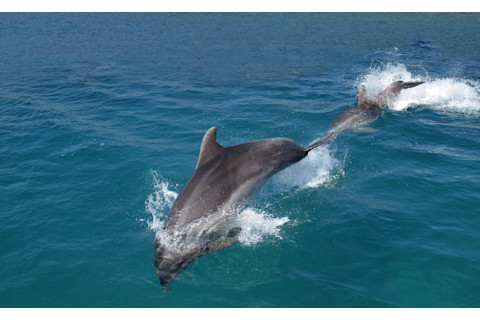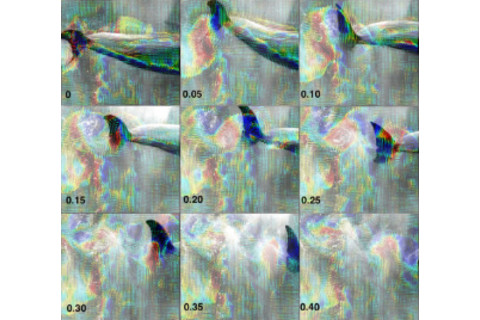
The “Acknowledgements” section of a scientific paper is usually a good cure for insomnia—just a list of names of collaborating scientists and funding agencies. So what is the U.S. National Swim Team doing in the acknowledgements of a new paper on dolphins? Turns out our swim team held the answer to one of marine biology’s oldest conundrums—how dolphins swim so fast with limited muscle power. The problem dates back to 1936, when Sir James Gray
studied a dolphin clocked swimming at 22.4 mph around a boat (note: that’s fast for water). Using a simple hydrodynamic model and what he knew about the dolphin’s size and power, Gray concluded that there was no way the dolphin could move that fast without some fluid mechanics wizardry, such as some special technique to modify the flow of the water and reduce the amount of drag. Herein lay what became known as “Gray’s paradox”
—short of having the same trainer as Alex Rodriguez
, how could dolphins move at that speed? At the height of the Cold War, a German scientist named Max Kramer
claimed to have solved the puzzle. By covering a torpedo with simulated dolphin skin made of a rubber membrane underlain with viscous fluid, he demonstrated that a dolphin (or at least a torpedo dressed like one) could modify the flow of water in precisely the way that Gray had imagined in order for the animals to reach their observed speeds. The Americans and Soviets took notice. Not so much for Flipper’s sake, but rather to design other oblong objects that could race through water, namely submarines and missiles. Turns out the Americans were unable to duplicate Kramer’s work, and while the Soviets made claims, no solid evidence has ever surfaced of their success.
A Fish Called Frank
And so the paradox persisted. Until this month, when a scientist named Frank E. Fish announced an answer. (Real name, we promise.) Fish, a marine biologist at West Chester University
and the lead author on the new study
in the Journal of Experimental Biology, had long been searching for a way to directly measure the thrust, and thus power, of a swimming dolphin. A dolphin propels itself forward by moving its tail with its lateral flukes, while its flippers steer. The flukes push on the surrounding water, and the water pushes back, creating thrust. According to Fish, most early attempts to measure thrust focused on estimating drag, since the two equal each other for a body moving at constant speed (Newton’s third law). But such experiments were often based on dragging a static body through water, and thus did not fully capture the forces at work when an object actively moves through the water, as a dolphin does while swimming. “Back in the early 90s, I decided not to worry about the drag,” Fish said. Instead, he focused on improved hydrodynamic models that took into account the flexibility of the flukes in an attempt to more directly measure thrust. Still, it wasn’t until the development of a technique called particle image velocimetry
(PIV) that Fish saw real hope. In this technique, used to measure the forces exerted by swimming fish, a high-speed video camera follows the movement of tiny glass beads dropped into a tank and illuminated by a laser. By tracking the movement of the beads through the water as the fish beats its fins or tail, researchers could calculate the speed of the beads and then back-calculate the thrust exerted by the fish. It showed promise.
Tiny Bubbles
But there was a catch. “Dolphins are rather pampered animals,” Fish said. “No one’s going to let you take little glass beads and put them in a tank with dolphins. No one’s going to let you shine laser beams at them either,” he said. Indeed, the Marine Mammal Protection Act
and other such legislation exist for good reasons. But around that time, Fish got a flash of inspiration from an unlikely source. At a mechanical engineering conference at Princeton, Fish ran into Tim Wei, an engineer who was presenting some of his research on the hydrodynamics of competitive swimmers
. “Tim had the same problem,” Fish explained. “He had pampered animals also, except his pampered animals were Olympic swimmers.” Wei had designed a modification of PIV to help the U.S. swim coaches break down the individual strokes and movements of their athletes. By using bubbles and natural light, instead of glass beads and lasers, Wei could humanely test on humans. Fish knew he had his answer.
Primo Donna
Grabbing Wei and grad student Paul Legac, Fish darted for UC Santa Cruz, where his buddy Terrie Williams had two bottlenose dolphins, Primo and Puka, that could serve as test subjects.

A dolphin progresses through a stroke cycle, with time shown in seconds. Velocity vectors are colored; red corresponds to counterclockwise rotation and blue indicates clockwise rotation. Credit: Fish et al. The team bought a soaker hose, in which water seeps out of several tiny pores, and placed it at the bottom of a pool. They pumped compressed air through the hose, creating a curtain of tiny bubbles. Trainers then directed Primo and Puka to swim through the curtain while a video camera taped the location and movement of the bubbles. From there, it was simple to calculate the thrust exerted by the dolphins’ flukes. Although they reached a speed of only 8.3 mph, the dolphins exerted 5.4 kilowatts of power, more than enough to explain their top swimming speed without invoking any hydrodynamic Houdini (and that top speed of 22.4 mph studied by Gray may have been a specious observation after all, as Fish said the dolphin may have been riding the boat’s bow wave rather than moving on its own). Thus Fish’s findings indicate that Gray’s paradox is no paradox after all, as dolphins have sufficient power and musculature to explain their speed. This is in line with other work by Tom Lang, a former Navy researcher, that came to similar conclusions. Now that that’s done, however, Fish is thinking bigger. With this technique, “we’re not limited by size,” Fish said. “Why not try to do it on a whale?” Talk about a big Fish in a small pond.
Top image courtesy Figen Ciftci
/ Shutterstock













